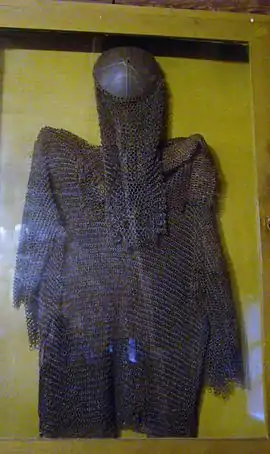Pintea the Brave
Grigore Pintea, aka Pintea The Brave (Hungarian: Pintye Vitéz; February 25, 1670 in Hollómező, Principality of Transylvania (today Măgoaja, Romania – A)ugust 14, 1703 in Nagybánya, Kingdom of Hungary (today Baia Mare, Romania)), was a famous heroic haiduc (rebel) stemming from Măgoaja, Lăpuș Country.[1]
„Have you heard of such brave,
With such a merciful heart,
Of a such great brave,
He is helping the poor”

According to biographical records, Grigore Pintea, son of Cupșa Pintea and Mălinei (born Costan), was born in 1670 as a descendant of petty Romanian nobility - as Ioan Cupșa - from Hollómező (now Măgoaja) in Belső-Szolnok Country. According to legends, ballads, and movies, he antagonizes regional nobles and decides to fight against social injustice. He flees to the forests of the nearby Máramaros County and lives like a Robin Hood (haiduc). During those years, he terrorized local nobility, who strove to catch him, but according to legends, he evaded them.[2]
Ioan Cupșa in 1681 has built the Nicula Monastery from Doboka County, donating the famous weeping icon of Mary. On the lands of the same Cupșa family lays the commune Cupșeni from the Máramaros County.
During the reign of emperor Leopold I, taxes levied by Habsburgs in Transylvania led to the Kuruc revolt. In this context, Francis II Rákóczi started a national freedom fight based on serfs, and on a help promised by the king of France ( Louis XIV) and the czar of Russia (Peter the Great).
Grigore Pintea was made captain, in the army of Francis II Rákóczi. Pintea was educated, knowing many foreign languages and military techniques, studied in imperial garrisons. Performing diplomacy as a good negotiator (resulting the protocols of January 1700 with the leaders of the Szatmár (Satu Mare) citadel, count F. Löwenburg, Pintea was declared "one of the most significant Romanians from the XVII-th century".[3]

In spring 1703, several cities in the north of Transylvania - Zilah (Zalău), Szatmár (Satu Mare), Beszterce (Bistrița), Dés (Dej), Máramarossziget (Sighetu Marmației) are taken by the revolt. Pintea's army had the task to conquer the Nagybánya (Baia Mare) citadel. In August the citadel is under siege. In an ambush, Pintea is fatally shot (August 14) in front of the southern gate of the citadel, close to the Tower of the Slaughterers.
In the church of Budafalva (Budești) there is the iron shirt and helmet worn by Pintea in fights against Tartars, and in the Nagybánya (Baia Mare) museum one can see his weapons and horse tools.
Many places in the region have names mentioning Pintea and his band of outcasts: Pinteas's Spring, Pintea's House, Pintea's Fountain, Pintea's Band, Pintea's Peak and Pintea's cavern. Legends talk about money hidden in caverns by Pintea.
Presumed funeral monument
In the center of a tight loop of the curvy mountain road descending the Gutin Mountains towards Nagybánya (Baia Mare), first turn below the Pintea Viteazul restaurant marking the highest point of the pass, one can see his impressing funeral monument (maybe his cenotaph). On the marble tomb-stone one can read the text: “The legend tells that Pintea The Brave, whose life was cut short by the tricks of the Baia Mare nobility on August 7, 1703, was buried in this place by his soldiers”.
Movies
Pintea the Brave was the subject of the movie Pintea (1976) staging Florin Piersic in the principal role, directed by Mircea Moldovan,[4] considered as one of the most seen Romanian movies. The movie may not be accurate in all historical details, as new information emerged about the final parts, but it is artistically a success. It features many local cultural details and songs. The movie was recorded in the geographical area of Baia Mare.
References
- Papahagi, Tache, 'Graiul și folklorul Maramureșului', Editura Academiei, București, 1925, ediție online.
- Gaftone, Vasile, Pintea Viteazul-oștean, în Memoria Ethnologica, nr. 6-7, Baia Mare, 2003
- Nicolae Densușianu, 1883
- Pintea (1976), https://www.imdb.com/title/tt0075067/